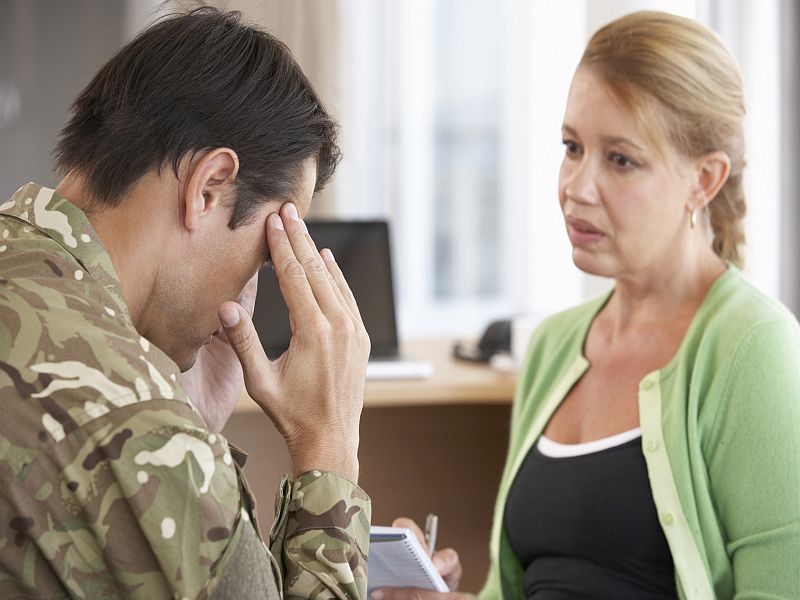Soldiers' Odds for Suicide Quadruple When Loaded Gun at Home
By Alan MozesHealthDay Reporter

FRIDAY, June 7, 2019 (HealthDay News) -- Owning their own firearm, carrying it in public and keeping it loaded in the home: These three factors are each tied to a fourfold rise in the likelihood that a U.S. soldier will take his or her own life, a new report finds.
Suicides among soldiers remain rare, but numbers have been on the rise in recent years, noted study lead author Dr. David Benedek.
And his team's research "replicates earlier findings in other groups that demonstrated an increased risk of suicide with gun ownership," said Benedek, a colonel and chair of the department of psychiatry at Uniformed Services University in Bethesda, Md.
The study also "brings to light some new questions clinicians might keep in mind when they are assessing risk of suicide with their [enlisted] patients," he said.
The findings were published online June 7 in JAMA Network Open.
In their study, Benedek's team reviewed the circumstances surrounding the suicides of 135 active-duty soldiers between 2011 and 2013.
The study found that suicide risk rose significantly for soldiers who carried a personal (not military-issue) handgun while in public, in a manner unrelated to any job duties. Keeping the personal handgun loaded in the home also greatly hiked suicide risk.
All of these factors were linked to a fourfold increase in suicide risk, Benedek said.
Still, he cautioned that not every soldier who owns a handgun is at high risk of taking their own life.
"Despite the increased suicide rate noted in recent years, suicide remains a rare event," he stressed.
Nevertheless, the research team noted that suicide rates among U.S. soldiers did start to inch upwards once the Iraq and Afghanistan wars got underway. And while those rates peaked in 2012, the rate at which active-duty soldiers lose their lives to suicide currently exceeds the rate at which they die in combat, Benedek's team said.
But as to the reasons why, that's less clear, he said, and gun ownership is likely only part of the puzzle.
"No single risk factor or group of factors identified to date can predict specifically who will commit suicide," Benedek said.
The new research also relied on interviews with 168 next-of-kin and/or Army supervisors of soldiers who had become victims to suicide. These interviews provided information on how the soldiers took their lives, as well as their gun ownership and storage habits.
In the end, investigators found that firearms were by far the most common suicide method. Of the 111 soldiers for whom a clear method of suicide was identified, 61 had used a gun.
The study wasn't designed to help devise ways to prevent future tragedies, Benedek noted. But he said that recently discharged soldiers can end up requiring psychiatric hospitalization, or may be struggling with depression or substance use disorders.
So, "questioning these patients about gun ownership, storage and carrying practices, and providing information to patients about the increased risk certain practices convey, may lead to decisions that reduce risk," Benedek said.
Dr. Joseph Simonetti is a clinician investigator with the Rocky Mountain Mental Illness Research, Education and Clinical Center for Suicide Prevention. The center is part of the Rocky Mountain Regional VA Medical Center in Aurora, Colo.
In an accompanying editorial (co-authored with Dr. Al Rowhani-Rahbar), Simonetti noted that suicide remains the 10th leading cause of death in the United States.
So, "efforts to limit access to lethal means -- (such as) firearms -- are an important element of suicide prevention programs and are especially relevant among U.S. veterans and service members," he said.
In his opinion, "the safest recommendation is still that adults consider temporarily storing their firearms elsewhere while they're at elevated risk of suicide," Simonetti said.
"However, for those who won't consider removing their firearm from the home, this study provides supportive evidence that there are steps we can take within the home to keep us safe," he added.
According to Simonetti and Rowhani-Rahbar, those steps include advising soldiers to keep personal firearms unloaded while in the home and/or keeping them secured with external locking devices.
More information
There's more on suicide prevention at the National Suicide Prevention Lifeline.

The news stories provided in Health News and our Health-E News Newsletter are a service of the nationally syndicated HealthDay® news and information company. Stories refer to national trends and breaking health news, and are not necessarily indicative of or always supported by our facility and providers. This information is provided for informational and educational purposes only, and is not intended to be a substitute for medical advice, diagnosis, or treatment.

